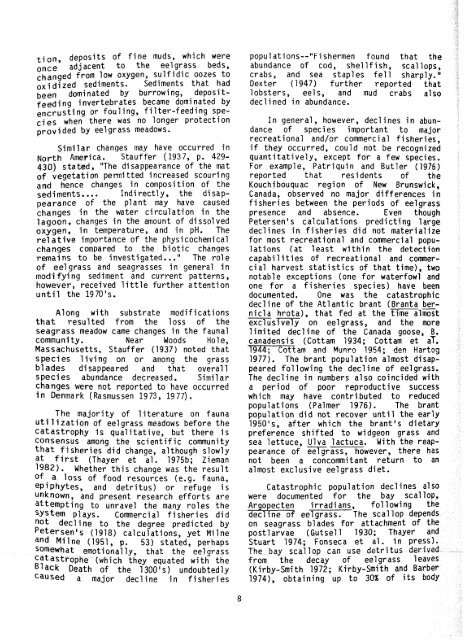The ecology of eelgrass meadows of the Atlantic coast
The ecology of eelgrass meadows of the Atlantic coast
The ecology of eelgrass meadows of the Atlantic coast
Create successful ePaper yourself
Turn your PDF publications into a flip-book with our unique Google optimized e-Paper software.
tjon, deposits <strong>of</strong> fine muds, which were<br />
adjacent to <strong>the</strong> <strong>eelgrass</strong> beds,<br />
changed from low oxygen, sulfidic oozes to<br />
OX i di zed sediments. Sediments that had<br />
been domi nated by burrowi ng, depositfeeding<br />
invertebrates became dominated by<br />
encrusting or fouling, filter-feeding species<br />
when <strong>the</strong>re was no longer protection<br />
provided by eel grass <strong>meadows</strong>.<br />
Similar changes may have occurred in<br />
North America. Stauffer (1937, p. 429-<br />
430) stated, "<strong>The</strong> disappearance <strong>of</strong> <strong>the</strong> mat<br />
<strong>of</strong> vegetation permitted increased scouring<br />
and<br />
hence changes in composition <strong>of</strong> <strong>the</strong><br />
sediments. .. . Indirectly, <strong>the</strong> disappearance<br />
<strong>of</strong> <strong>the</strong> plant may have caused<br />
changes in <strong>the</strong> water circulation in <strong>the</strong><br />
lagoon, changes in <strong>the</strong> amount <strong>of</strong> dissolved<br />
oxygen, in temperature, and in pH. <strong>The</strong><br />
re1 at ive importance <strong>of</strong> <strong>the</strong> physi cochemi cal<br />
changes compared to <strong>the</strong> biotic changes<br />
remains to be investigated.. ." <strong>The</strong> role<br />
<strong>of</strong> eel grass and seagrasses in general in<br />
modi fyi ng sediment and current patterns,<br />
however, received 1 i ttle fur<strong>the</strong>r attention<br />
until <strong>the</strong> 1970's.<br />
Along with substrate modifications<br />
that resulted from <strong>the</strong> loss <strong>of</strong> <strong>the</strong><br />
seagrass meadow came changes in <strong>the</strong> faunal<br />
community. Near Woods Hole,<br />
Massachusetts, Stauffer (1937) noted that<br />
species living on or among <strong>the</strong> grass<br />
bF ades di sap peared and that overall<br />
species abundance decreased. Similar<br />
changes were not reported to have occurred<br />
in Denmark (Rasmussen 1973, 1977).<br />
<strong>The</strong> majority <strong>of</strong> literature on fauna<br />
uti 1 ization <strong>of</strong> eel grass <strong>meadows</strong> before <strong>the</strong><br />
catastrophy is qualitative, but <strong>the</strong>re is<br />
consensus among <strong>the</strong> scientific communit~<br />
that f i sheries did change, a1 though slowly<br />
at first (Thayer et al. 1975b; Zieman<br />
1982). Whe<strong>the</strong>r this change was <strong>the</strong> result<br />
<strong>of</strong> a loss <strong>of</strong> food resources (e.g. fauna,<br />
epiphytes, and detritus) or refuge is<br />
unknown, and present research efforts are<br />
attempting to unravel <strong>the</strong> many roles <strong>the</strong><br />
System plays. Commercial fisheries did<br />
not decline to <strong>the</strong> degree predicted by<br />
Petersen's (1918) calculations, yet Milne<br />
and Milne (1951, p. 53) stated, perhaps<br />
Somewhat emotionally, that <strong>the</strong> <strong>eelgrass</strong><br />
catastrophe (which <strong>the</strong>y equated with <strong>the</strong><br />
Black Death <strong>of</strong> <strong>the</strong> 1300's) undoubtedly<br />
caused a major decline in fisheries<br />
popul ations--"Fi shermen found that <strong>the</strong><br />
abundance <strong>of</strong> cod, she1 lf ish, scal lops,<br />
crabs, and sea staples fell sharply."<br />
Dexter (1947) fur<strong>the</strong>r reported that<br />
lobsters, eels, and mud crabs also<br />
declined in abundance.<br />
In general , however, decl i nes i n abundance<br />
<strong>of</strong> species important to major<br />
recreational and/or commerci a1 fisheries,<br />
if <strong>the</strong>y occurred, could not be recognized<br />
quantitatively, except for a few species.<br />
For example, Patriquin and Butler (1976)<br />
reported that residents <strong>of</strong> <strong>the</strong><br />
Kouchi bouquac region <strong>of</strong> New Brunswick,<br />
Canada, observed no major differences in<br />
fisheries between <strong>the</strong> periods <strong>of</strong> <strong>eelgrass</strong><br />
presence and absence. Even though<br />
Petersen's calculations predicting large<br />
declines in fisheries did not materialize<br />
for most recreational and commercial populations<br />
(at least within <strong>the</strong> detection<br />
capabi 1 i ties <strong>of</strong> recreational and comercia1<br />
harvest statistics <strong>of</strong> that time), two<br />
notable exceptions (one for waterfowl and<br />
one for a fisheries species) have been<br />
documented. One was <strong>the</strong> catastrophic<br />
decline <strong>of</strong> <strong>the</strong> <strong>Atlantic</strong> brant (Branta ber-<br />
--<br />
nicla hrota), that fed at <strong>the</strong> timelmost<br />
exclusively on <strong>eelgrass</strong>, and <strong>the</strong> more<br />
limited decline <strong>of</strong> <strong>the</strong> Canada goose, 6.<br />
canadensis (Cottam 1934; Cottam et aT.<br />
1944; Cottam and Munro !954; den Hartog<br />
1977). <strong>The</strong> brant pcpulation almost disappeared<br />
following <strong>the</strong> decline <strong>of</strong> <strong>eelgrass</strong>.<br />
<strong>The</strong> decline in numbers a1 so coincided with<br />
a period <strong>of</strong> poor reproductive success<br />
which may have contributed to reduced<br />
populations (Palmer 1976). <strong>The</strong> brant<br />
population did not recover unti 1 <strong>the</strong> early<br />
19501s, after which <strong>the</strong> brant's dietary<br />
preference shifted to widgeon grass and<br />
sea lettuce, Ulva lactuca. With <strong>the</strong> reappearance<br />
<strong>of</strong> eel grass, however, <strong>the</strong>re has<br />
not been a concommitant return to an<br />
almost exclusive eel grass diet.<br />
Catastrophic population decl ines also<br />
were documented for <strong>the</strong> bay scallop,<br />
Argopecten irradi ans, following <strong>the</strong><br />
decline <strong>of</strong> eelarass. <strong>The</strong> scallop depends<br />
on seaqrass blides for attachment <strong>of</strong> <strong>the</strong><br />
post1 a&ae (Gutsel 1 1930; Thayer and<br />
Stuart 1974; Fonseca et al. in press).<br />
<strong>The</strong> Say scallop can use detritus derived<br />
from <strong>the</strong> decay <strong>of</strong> <strong>eelgrass</strong> leaves<br />
(Kirby-Srni th 1972; Kirby-Smith and Barber<br />
1974), obtaining up to 30% <strong>of</strong> its body

















